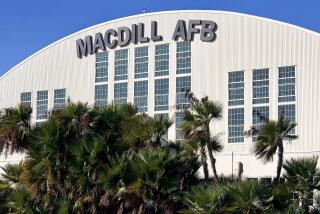Spy Plane Scans Antietam for Hidden Civil War Clues
- Share via
An airplane fitted with sophisticated radar and cameras invented for spy planes and satellites flew over the Antietam and Manassas battlefields this week on a high-technology archeological hunt for unmarked graves and hidden Civil War artifacts.
The flight allowed the National Park Service, which oversees the battlefields, to scan hundreds of acres quickly and cheaply.
The haste of combat resulted in dozens of unmarked graves at the two battlefields, officials said. The aerial search may help guide Park Service workers to those graves before they are found by looters in search of Civil War relics.
“We’re going to find some (graves) on the (Antietam) battlefield itself, no question about it,” said Stephen R. Potter, regional archeologist for the Park Service.
Potter said he believes there are dozens of undiscovered burial areas--particularly of Confederate soldiers--at Antietam, the Maryland battlefield where 23,110 men were killed, wounded or never found. The battle on Sept. 17, 1862, was the deadliest in U.S. combat history.
The flight was donated to the Park Service by the Environmental Research Institute of Michigan, a private, nonprofit laboratory that owns the plane and wants to expand its civilian uses.
The Park Service hopes to obtain Pentagon funding and use the images from Antietam and the Bull Run battlefields at Manassas, Va., to develop a “signature” of an unmarked grave that could help find more modern burial grounds.
The flight also may uncover campsites, trails, buildings or other Civil War-era features of the land, Potter said. Historians know, for example, that a now-destroyed orchard played a role in the combat at Manassas, and Park Service officials would like to find it.
The institute’s twin-engine Convair 580 has a conventional cockpit but some sophisticated equipment in the cabin--two high-resolution cameras and synthetic aperture radar, which penetrates clouds, foliage and even the ground.
The plane has been used mainly for U.S. and foreign missions to verify weapon installations under international treaties. The radar technology also has been used on spy planes and on a NASA mission to map Venus.
More to Read
Sign up for Essential California
The most important California stories and recommendations in your inbox every morning.
You may occasionally receive promotional content from the Los Angeles Times.













